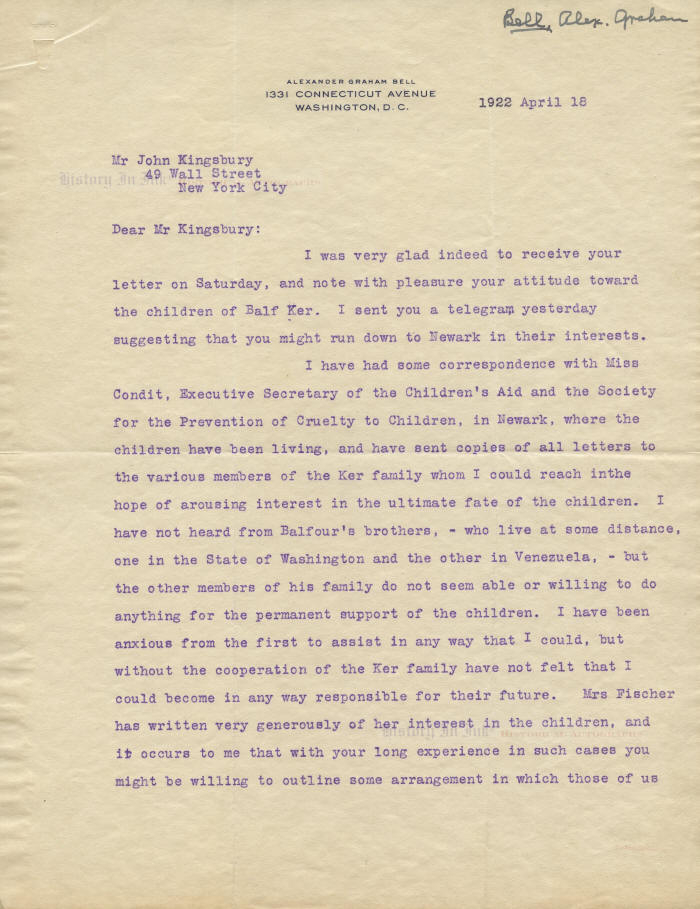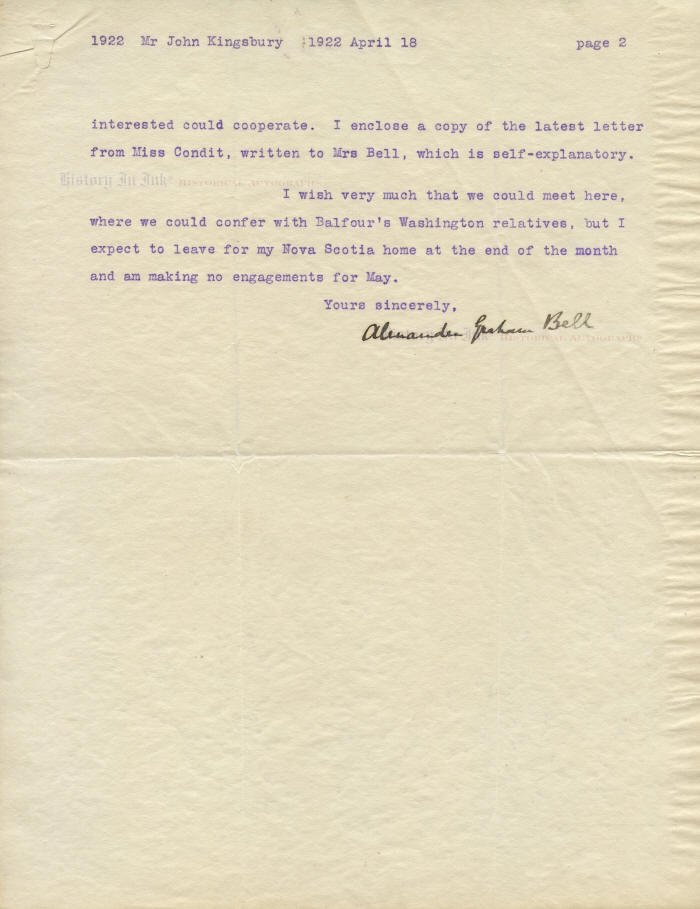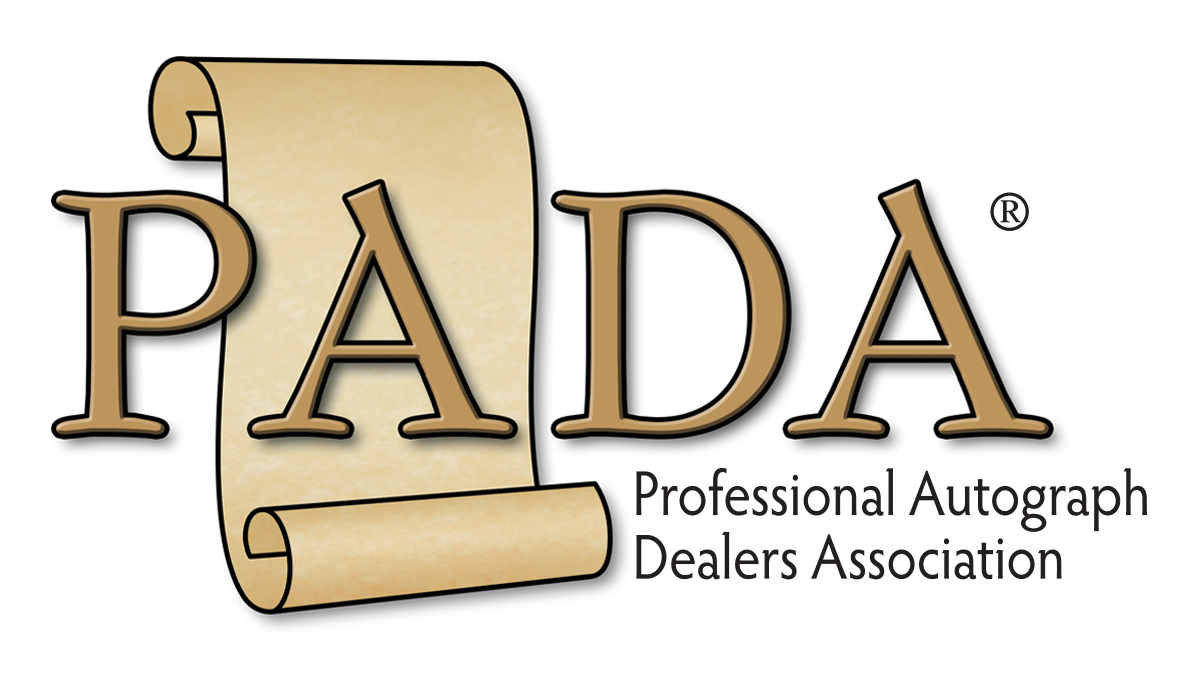


1834603
Alexander Graham Bell
A frustrated Bell seeks help for his cousin’s grandchildren after their parents’ deaths:
“I have been anxious from the first to assist in any way that I could, but without the cooperation of the . . . family
have not felt that I could become in any way responsible for their future.”
Alexander Graham Bell, 1847–1922. Inventor of the telephone. Typed Letter Signed, Alexander Graham Bell, two pages, 8½” x 11”, on personal stationery, Washington, D.C., April 18, 1922.
This is a poignant letter in which an anxious but frustrated Bell seeks help for his cousin’s orphaned grandchildren. He writes to famed New York social work leader John Adams Kingsbury about the children of William Balfour Ker, an artist and Life magazine illustrator whose mother, Lily Florence Bell Ker, was Bell’s first cousin. Ker had died four years earlier, and after his wife also died, his children had been living at the Society for the Prevention of Cruelty to Children in Newark, New Jersey.
Kingsbury had served as director of the prestigious New York City Association for Improving the Condition of the Poor and afterward as the city’s Commissioner of Public Charities, which was the most important public welfare position in the country. At the time Bell wrote this letter, Kingsbury was the Secretary of the Milbank Memorial Fund, a health research foundation, He also served as a member of the executive committee of the New York State Charities Aid Association.
Bell writes, in full:
I was very glad indeed to receive your letter on Saturday, and note with pleasure your attitude toward the children of Balf Ker. I sent you a telegram yesterday suggesting that you might run down to Newark in their interests.
I have had some correspondence with Miss Condit, Executive Secretary of the Children’s Aid and the Society for the Prevention of Cruelty to Children, in Newark, where the children have been living, and have sent copies of all letters to the various members of the Ker family whom I could reach in the hope of arousing interest in the ultimate fate of the children. I have not heard from Balfour’s brothers, – who live at some distance, one in the State of Washington and the other in Venezuela, – but the other members of his family do not seem able or willing to do anything for the permanent support of the children. I have been anxious from the first to assist in any way that I could, but without the cooperation of the Ker family have not felt that I could become in any way responsible for their future. Mrs Fischer has written very generously of her interest in the children, and it occurs to me that with your long experience in such cases you might be willing to outline some arrangement in which those of us interested could cooperate. I enclose a copy of latest letter from Miss Condit, written to Mrs Bell, which is self-explanatory.
I wish very much that we could meet here, where we could confer with Balfour’s Washington relatives, but I expect to leave for my Nova Scotia home at the end of the month and am making no engagements for May.
William Balfour Ker, to whom Bell refers here as “Balf” and “Balfour,” was born in Ontario on July 25, 1877. He immigrated to the United States with his parents in 1880 and became a naturalized American citizen in the 1890s. As a young man, he was a staunch Socialist, and his art often reflected his political philosophy.
Ker studied under famed illustrator Howard Pyle, where he met and married another of Pyle’s students, Mary Ellen “May” Sigsbee, in 1900. May’s father, Rear Admiral Charles D. Sigsbee, had commanded the ill-fated USS Maine, which exploded in Havana harbor, igniting the Spanish-American War. Ker and May had a son, David Balfour Ker, who was born in 1906. They divorced in 1911. May later married Anton Otto Fischer in 1912—and thus likely was the “Mrs Fischer” whom Bell mentions in this letter. Young David stayed with his mother and died in 1922, at age 15 or 16. Whether because of bitterness or because Ker had died four years before, David’s tombstone does not mention Ker but instead says that he was the “son of Anton Otto Fischer and Mary Sigsbee Fischer.”
It appears that Ker had met Delaware native Josephine Reeder Phillips, whom he later married in England. Our research shows that because of their strong Socialist leanings, they lived in England and France several years before they returned to the United States before World War I. They had four children, some before and some after their 1914 marriage: a daughter, Yosene, and three sons, John, Charles Waldron, and William. There is some suggestion that they, too, divorced, but in any event Ker died in New York on October 20, 1918, at age 41. Josephine died a few years later, leaving the four children, who at that point ranged in age from 4 to 10 years old.
Thus Bell’s concern for the children that he expresses in this letter.
Interestingly, Yosene married Lathrop Motley Weld in 1934. Her third child, Susan Ker Weld, became the actress Tuesday Weld (1943–). “Tuesday” was an extension of Weld’s childhood nickname, “Tu-Tu,” and Weld had her name legally changed to “Tuesday” in 1959. She was nominated for an Academy Award for Best Supporting Actress in Looking for Mr. Goodbar (1977).
This letter is on engraved stationery showing the address of Bell’s mansion in Washington, D.C., 1331 Connecticut Avenue, just south of Dupont Circle. Bell built the mansion in June 1891 at what was then a huge cost of $31,000. The house was demolished in 1930 to make way for an office building.
Bell has signed this letter in black fountain pen. The pen began to run out of ink on “Bell,” and the last two letters are a bit light but nevertheless easily readable. The letter has horizontal and vertical mailing folds, one of which runs through the “h” in “Graham.” A stray diagonal fold on the second page barely touches the “B” in “Bell.” The letter also has some moisture rippling along the vertical edges, affecting nothing. The paper is punched in the blank upper left corner to bind the sheets together, and there are small staple holes there as well. Bell’s name is written in ink in another hand at the top right of the first page. Overall, the letter is in fine condition.
Unframed.
_____________
This item has been sold, but
click here to see other
American History items
that we are offering.



